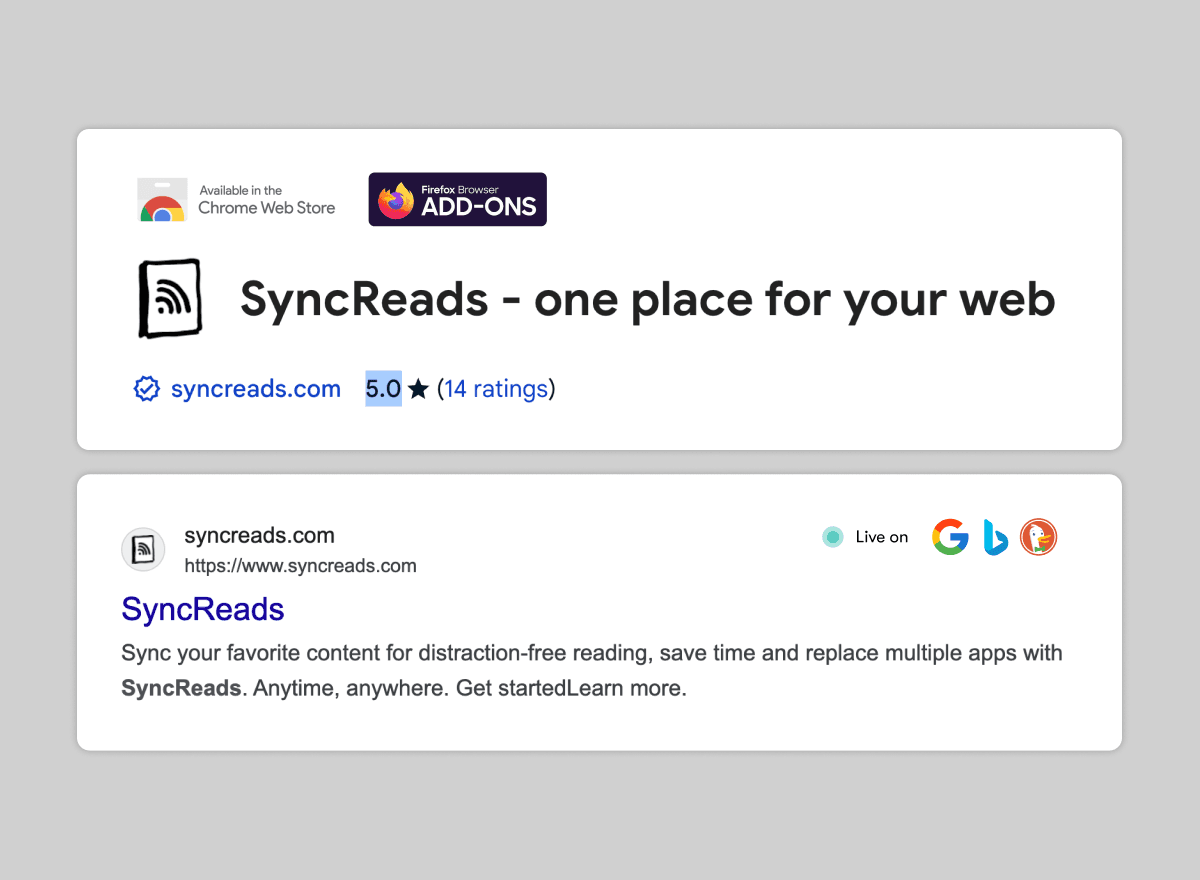The app was initially designed to be my go-to place when I wanted to search for something in my library of web resources. It allows users to sync their favorite content for distraction-free reading, saving time and replacing multiple apps with just one.
The focus was primarily on the user experience and performance, making it as easy and fast as possible to consume web content.
EDIT: This project is officially my first SaaS that I made money from 🥹
Tech stack
When I was talking about this project with my friends, I found out that it's best to show the architecture and decisions on a diagram.
That's why I created some more production-ready graph than my unorganized scribbles and put it here:
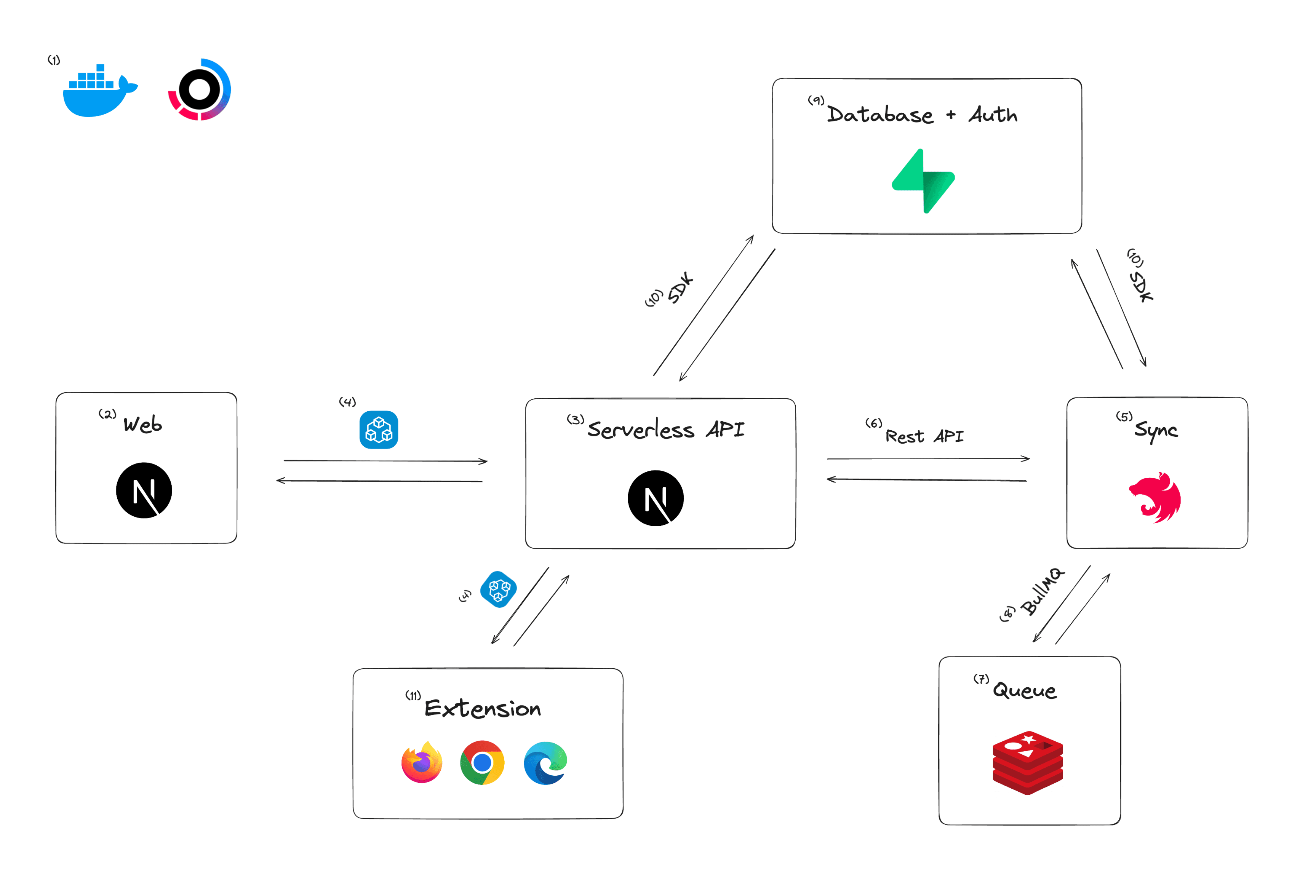
Let's talk about it a bit more.
Architecture
-
Starting from the main setup, Docker and Turborepo were utilized to create a perfect development environment. The separation of concerns in this monorepo helps keep the codebase clean and structured.
It is also used to simplify the process of deployment and testing the app, enabling us to run multiple tasks in parallel 📦
-
The web app is the primary interface that users see, built with Next.js App Router to harness the benefits from RSC and keep performance under control.
-
Leveraging the full power of Next.js we employ serverless API and Edge functions 🔥 mainly for CRUD operations on the database or non-resource-intensive computations on given data. Being a built-in part of Next.js it's super easy to maintain.
-
The connection between the frontend and serverless API is facilitated by tRPC, enforcing full type-safety and conventions across different operations.
Seamless validation is achieved with Zod, ensuring our data is in the correct shape.
-
The Sync module, the main character in this theater, is a strictly separated backend built with Nest.js responsible ONLY for sync functionality.
As operations here could be resource and time-intensive, we can scale and extend it independently from the main flow to ensure a good user experience while background tasks are executed 📈
-
To initiate synchronization, a simple HTTP request is made. The goal is to make it as simple as possible for third-party tools to integrate with this part by just making a request.
Communication follows a pure REST API approach using endpoints exposed by the backend, with the request requiring authorization through a special user-specific token.
-
Sync performance, a potential concern, is addressed by using queues. A straightforward Redis instance with reasonable limits ensures smooth operation.
Incoming requests are pushed to the correct queue, and when their time comes, our main service processes them.
-
BullMQ is used to communicate with our queues, a library dedicated to managing structures like this.
Easy integration with Nest.js, multiple features, and a developer-friendly API enable us to avoid complicated syntax to achieve simple goals 💡
-
But where is the data? Short question = short answer. Supabase. It uses PostgreSQL under the hood, so we won't bother about strictly db things.
With a range of useful services that can be integrated in minutes (e.g., realtime, auth), it allows us to focus on business value rather than low-level implementation details.
-
There are several ways to communicate with the database, but SyncReads places its bet on the official JavaScript SDK.
Simple, handy, and performant, it eliminates the need for writing tons of abstractions over the database to obtain the desired data.
-
If you don't already know, SyncReads has also a browser extension (available for Chrome, Firefox, Edge etc.), which allow you to save content from the web with just one click.
It's built with React and Vite which is simple, yet powerful combination.
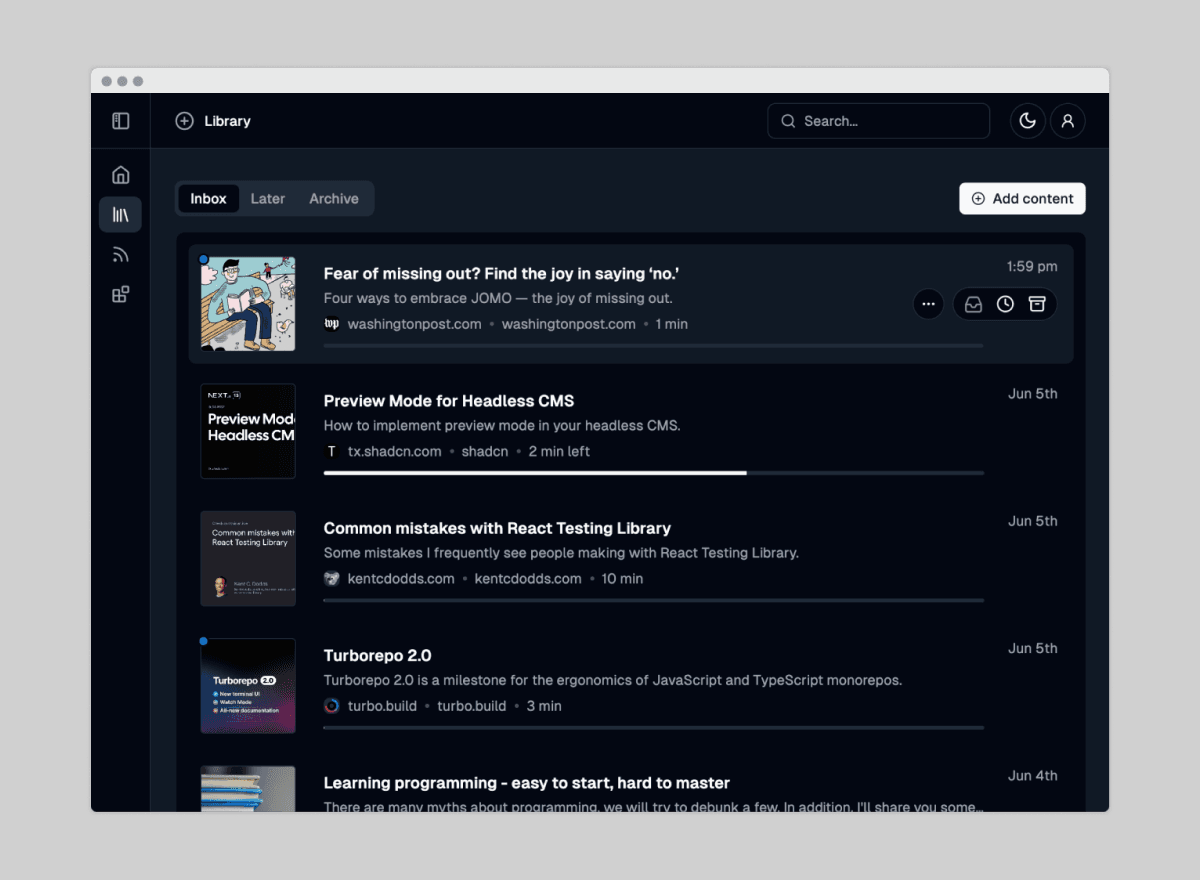
Design
I was horrible at design.
I mean, probably I still am (😅), but I improved A LOT. I read multiple books (e.g. Refactoring UI) and watched tons of tutorials to get better at it.
After all, when I see that someone says "it looks neat" or "I like the colors" I feel like I finally achieved something 💪
What I'm trying to say is that I designed the whole app myself. From the logo, through the landing page, to the app itself.
It won't be possible to implement it fast, without my favorite Tailwind and a lot of accessibility help from Radix UI.
A lot to show and talk about, but, I'm still most proud of THIS 👇
PS. You can see it live directly on the homepage 🔥
Problems
From a technical standpoint, the biggest challenge was making the sync process as fast as possible.
Developing a monorepo with separate deployments to different platforms through one unified pipeline was also challenging, but it was worth it.
However, two things were even harder... 😬
Marketing
Marketing is probably every developer's nightmare 🫣
I had to learn a lot about SEO, growth hacking, copywriting, and social media. I'm still learning, but I'm happy to see some results.
Most of my users came from my 𝕏 (Twitter) account, but I'm constantly working on providing more and more traffic sources.
At the end of the day, a happy customer is what motivates me the most.
Product fit
Achieving market fit is crucial for the success of any product 🔥
For SyncReads, this meant ensuring that the product not only solves a real problem but also meets the needs and preferences of its target users. Before diving into development, I conducted extensive user research to understand the needs, pain points, and behaviors of potential users.
The primary pain point SyncReads addresses is the hassle of synchronizing data across different platforms and devices 🔄
Users needed a seamless way to keep their information updated without manual intervention. By analyzing competitors and existing tools, I identified gaps in the market. Many tools were either too complex, lacked essential features, or were not user-friendly.
SyncReads aimed to fill these gaps by providing an intuitive and efficient solution.
I started with an MVP to quickly test the core functionality of SyncReads. This early version focused on the essential features needed for data synchronization and received feedback from a small group of users.
Based on user feedback, I iteratively improved the product. This agile approach allowed me to continuously refine SyncReads, adding features that users found valuable and removing or modifying those that did not meet their expectations ⭐
Encouraging satisfied users to become advocates helped spread the word about SyncReads. User testimonials, case studies, and referral programs leveraged the power of word-of-mouth marketing.
This is how I achieved my first SaaS sale 🚀
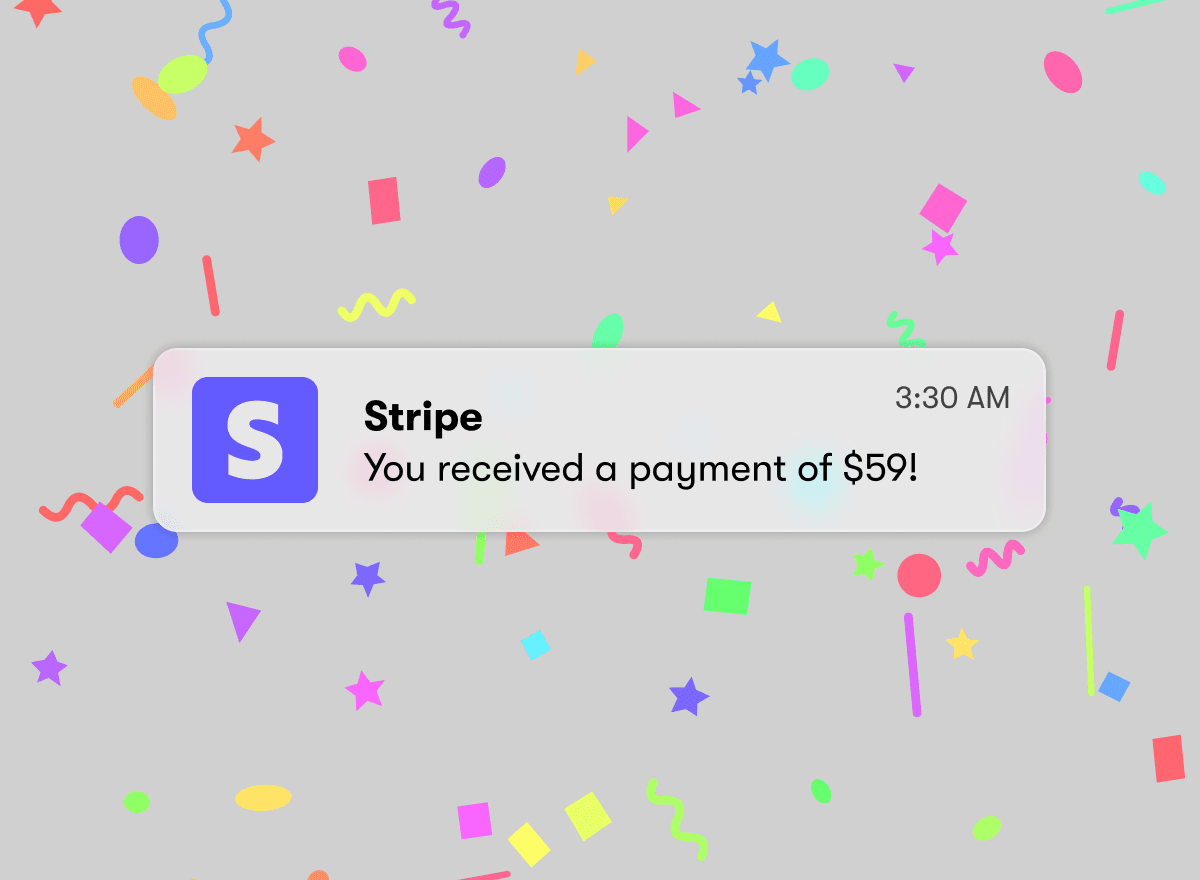
Lessons learned
Building a product from scratch to market launch taught me more than 10 years of commercial programming.
My friend a few years ago
After doing it, I can say it's true ✅
It's not only about coding - I now think that coding is the easiest part of the whole process.
It's about marketing, sales, customer support, SEO, growth hacking, copywriting, design, product management, and many more.
Saying "I learned a lot" would be an understatement.
I discovered a whole new world of possibilities, and I'm happy to be a part of it. (#buildinpublic 🙏)
Online presence
To build an online presence for the product, I posted regular updates on 𝕏 (Twitter) and Reddit.
I even made the whole app open-source at one point, but it didn't go well due to a high entry barrier ❌
Despite this, I kept pushing forward with my roadmap and implementing user feedback in real-time. I also discovered Product Hunt and the indie hackers community, where I shared my journey and received valuable feedback.
Looking back, I gained a lot of new connections, had tons of insightful conversations, and reviewed thousands of products made by ambitious people.
What do I regret?
Not starting earlier 😢
If you want to start, just do it. TODAY.
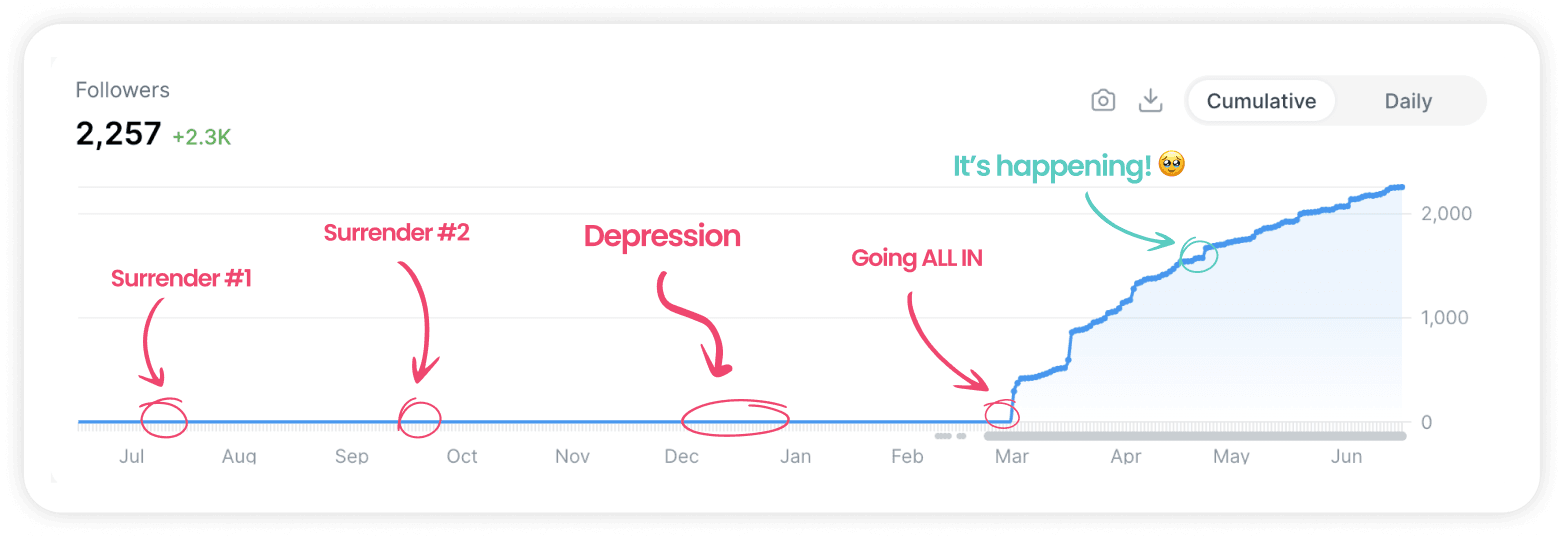
SEO
I didn't realize how important SEO is in today's world.
If your app isn't listed in the search engine, it's like it doesn't exist 🥶
There are still things to do, but I'm proud that I managed to get some organic traffic.
- User testimonials
- Case studies
- Blog posts
- Reviews
Helped me get some backlinks and improve the ranking. They made me a lot, but I know I'll do much better in the future 💪
What's next?
Well, if you've made your first sale, then the moon should be your next destination... 🚀
